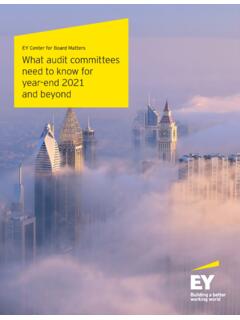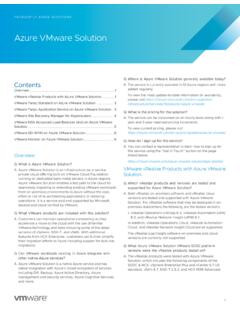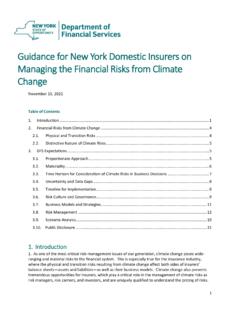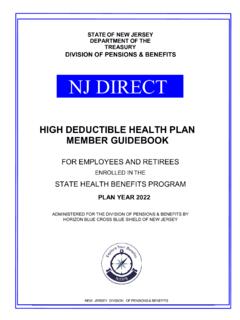Transcription of Guidance How to draw up your H2020 consortium agreement
1 1 Guidance How to draw up your H2020 consortium agreement Version 07 January 2020 EUROPEAN COMMISSION Directorate-General for Research & Innovation EU Grants: Guidance How to draw up your consortium agreement : 2 HISTORY OF CHANGES Version Publication Date Change n/a Initial version LS review Updated to / PP > FTP references EU Grants: Guidance How to draw up your consortium agreement : 3 IMPORTANT NOTICE This document aims to assist applicants/beneficiaries in drawing up a consortium agreement for Horizon 2020 projects ( mandatory for all multi-beneficiary projects, unless the call/work programme provides otherwise). The consortium agreement should set the framework for a successful project implementation ( settle all issues that might hamper the smooth and seamless cooperation of the different actors for the different parts of the project).
2 It should in principle be negotiated and concluded before signing the grant agreement . Figure 1 consortium agreement time-line diagram The consortium agreement is a private agreement between the beneficiaries, to set out the rights and obligations amongst themselves. ( It does NOT involve the European Commission/Agency.) It should complement the grant agreement and must NOT contain any provision contrary to it. You remain fully responsible for your consortium agreement . This document is necessarily general and may not address your specific needs. For complex consortia, you should seek professional legal advice if needed. Other information This document is limited to the consortium agreement for H2020 projects. For a more general overview of how Horizon 2020 grants work, see the Online Manual.
3 For detailed information, see the H2020 AGA Annotated Grant agreement on the Funding & Tenders Portal. A comprehensive list of Horizon 2020 reference documents (including legislation, work programme and templates) can be found in the Reference documents page of the Funding & Tenders Portal. Horizon 2020 terms are explained in the Glossary of the Funding & Tenders Portal. If you need help, you can also contact the Research Enquiry Service helpdesk. EU Grants: Guidance How to draw up your consortium agreement : 4 Table of contents 1. Proposal phase: Preparing the consortium .. 5 Typical issues & how to address them .. 5 2. Grant preparation phase: Setting-up the consortium agreement .. 8 Typical issues & how to address them .. 8 EU Grants: Guidance How to draw up your consortium agreement : 5 1.
4 Proposal phase: Preparing the consortium During the proposal phase, you will need to commit yourselves to a common project and draw up a joint proposal. You will need to: share important information about the state of play of your research, your approach to the project, and the goals that your proposal is to meet negotiate your project's technical and commercial specifications Avoid focusing too much on specific internal policies or strategies. share information about your operational capacity (to see how it complements others capacity), pre-existing intellectual property ( background ), etc. submit information on your operational capacity to the Commission/Agency choose a name for your project prepare the consortium agreement (preferably by drafting an outline or draft consortium agreement ) Typical issues & how to address them Typical issues arising at the proposal stage include the commitment to the project, the confidentiality of the information shared and the choice of a name or acronym for the project.
5 Formalising the commitment During the proposal phase (and before submitting the proposal), you should formalise your negotiations (through a letter of intent or as part of a confidentiality agreement ; see below). This will give you some legal certainty. It will also facilitate cooperation and the exchange of information. Letters of intent or memoranda of understanding are agreements outlining the framework for negotiations between applicants, usually drawn up at the outset of negotiations on involvement in a project. A letter of intent is not usually legally binding, but applicants could include some binding rules ( confidentiality obligations). Even if non-binding, a letter of intent is more formal than a gentlemen s agreement , which is often unwritten.
6 Signing a letter of intent is an official sign that the applicants have a shared interest in achieving a given result, and may make a successful outcome more likely. The letter of intent (or confidentiality agreement ) should set out: the shared intentions ( taking part and the substance of the proposal) rules on communication, sharing information, confidentiality and reporting (unless included in a separate confidentiality agreement ) the conditions of termination. EU Grants: Guidance How to draw up your consortium agreement : 6 This gives the parties a framework for further negotiations. Moreover, it allows the coordinator to declare that all applicants have explicitly consented to: taking part and the substance of the proposal. Sharing information Confidentiality issues Sharing information between applicants entails a risk of it being disclosed or used for the wrong purpose.
7 To avoid any such misuse, applicants should commit themselves (either in the letter of intent or in a separate confidentiality agreement ) to honouring certain confidentiality obligations. They should accept restrictions on: using confidential information disclosing it. Confidentiality agreements are agreements that set out the conditions under which applicants may disclose or use secret or confidential information ( the research idea for the project). The confidentiality agreement should typically set out: a definition of what constitutes confidential information the confidentiality obligations (including their scope and duration) penalties for breach of confidentiality obligations (if necessary) Confidentiality obligations: scope.
8 The confidentiality agreement should set out that it is permissible to pass on confidential information shared among applicants to a specified circle of persons/organisations, on a need to know basis and subject to certain conditions. Applicants may, for instance, need to share confidential information with identified linked third parties that will participate in the project ( non- consortium organisations with which they have links). Define the concept of linked third party using the definitions in the Model Grant agreement , to make it clear which organisations or individuals are subject to confidentiality obligations. To avoid requiring the linked third parties to sign confidentiality obligations, you can guarantee that any confidentiality obligations to which you are subject also apply to your linked third parties (as defined in the confidentiality agreement ).
9 When establishing confidentiality obligations, remember that the links between a linked third party and an applicant may be severed. (For instance, the entity could be sold or merged with another organisation. You could stipulate that in such cases the entity concerned must return any confidential information it has received.) EU Grants: Guidance How to draw up your consortium agreement : 7 Similarly, applicants may need to disclose information to employees or other staff. Although employees often have a duty of confidentiality to their employer under national labour law, they should be made aware of their specific obligations to keep this information confidential. You should explicitly guarantee that employees or other staff with whom the information is shared will keep it confidential.
10 Employees confidentiality obligations should preferably continue after they stop working for you, if national law allows this. Confidentiality obligations: duration. The confidentiality agreement should set the time-limit of the confidentiality obligations (typically starting from either the date on which the agreement takes effect or the date on which the confidential information was given). Penalties for breach of confidentiality. A breach of confidentiality may cause significant damage but the damage may be difficult to prove. To prevent this, you may wish to include a contractual penalty in the confidentiality obligations (if allowed under national law). Project name Trademark issues At the proposal stage, you and your fellow applicants must choose a name and acronym for your project.













